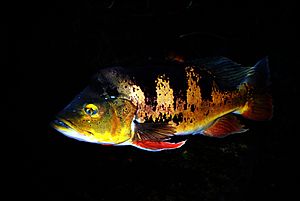Cichla ocellaris facts for kids
Quick facts for kids Cichla ocellaris |
|
|---|---|
 |
|
| Scientific classification | |
| Synonyms | |
|
Acharnes speciosus Müller & Troschel, 1849 |
The Cichla ocellaris, also known as the butterfly peacock bass, is a very large type of cichlid fish. It comes from South America and is a popular fish for sport fishing. This fish can grow up to about 74 centimeters (29 inches) long.
It naturally lives in the Marowijne and Essequibo river systems in a region called the Guianas. It is also found in the Branco River in Brazil. This fish has been moved to other places like Florida, Hawaii, and Puerto Rico. Scientists believe introducing this fish in Florida has not harmed other fish. Instead, it helps manage fish populations.
Contents
What Does the Butterfly Peacock Bass Look Like?
The butterfly peacock bass has a body shape similar to a largemouth bass. It can grow up to 29 inches long, but most are about 12 to 14 inches. Their colors can be yellow, green, or light red to orange.
The most noticeable feature is three black lines along its sides. These lines might fade on older fish. The fish gets its "peacock" name from a black spot on its tail fin. This spot has a yellow ring around it, making it look like a peacock's feather.
Where Do Butterfly Peacock Bass Live?
This fish is originally from the tropical parts of the Americas, mainly the Guianas. It loves warm, slow-moving water. You can find them in lakes, ponds, canals, and rock pits.
Like other bass, they often hide in shaded spots. Look for them under trees, bridges, or culverts. Butterfly peacock bass cannot live in very salty water. They also cannot survive in water colder than 60 degrees Fahrenheit (15.5 degrees Celsius).
Where Are They Found Now?
In 1984, the Florida Fish and Game Commission brought this fish to south Florida. They released about 10,000 young fish into lakes and canals in Miami-Dade County. These fish spread through the warm, freshwater canals of Florida.
They are thought to live in about 300 miles (500 km) of canals. Because they cannot handle cold or salty water, they are mostly found in Miami-Dade and Broward County. Some have also been seen in Texas and Louisiana. This species has also been introduced in large numbers to Trị An Lake in Vietnam.
How Do They Eat and Help the Environment?
Bringing the butterfly peacock bass to Florida has helped control other fish. It has successfully managed populations of tilapia and oscar fish. These fish were once causing problems by becoming too numerous.
The butterfly peacock bass mainly eats other fish. This makes them important for keeping the balance in their habitat. They usually hunt during the day when they can see better. Like other bass, they use their amazing speed and large mouths to catch their prey.
Spawning Habits
Butterfly peacock bass usually lay their eggs between April and September. The busiest time for spawning is in May and June. Adult fish make large, flat, hard areas near the shore. These spots serve as nesting places. Once the eggs are laid, both parent fish work together to protect them from predators.
How Fast Do They Grow?
Young butterfly peacock bass grow very quickly. They reach their average length of 12–14 inches within their first 16–18 months. After that, for every extra inch they grow, they can gain about 1.5 pounds of weight. The average lifespan for a butterfly peacock bass is 6 to 10 years.
Game Fishing for Butterfly Peacock Bass
This fish is considered the most popular sportfish in south Florida. Millions of anglers travel there each year to fish for them. They spend a lot of money on fishing trips and gear. You can catch them from a boat or from the shore.
Fishing for butterfly peacock bass is similar to fishing for largemouth bass. Anglers often use live shiners as bait. Topwater jigs and jerkbaits are also popular lures. In Florida, there is a daily limit of two fish per person. Each fish must be at least 17 inches long.
Can You Eat Butterfly Peacock Bass?
Many people say the butterfly peacock bass tastes very good. Its meat is clean, white, and flaky. Some even say it does not have a "fishy" taste. However, people do not eat them very often. This is because state rules require the fish to be a certain size before you can keep it.
See also
 In Spanish: Pavón cinchado para niños
In Spanish: Pavón cinchado para niños

